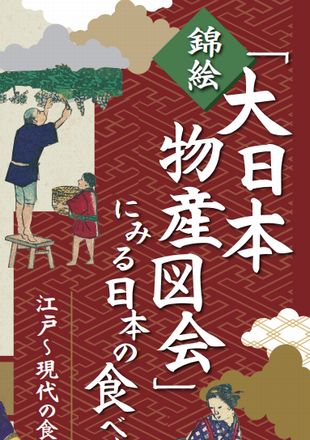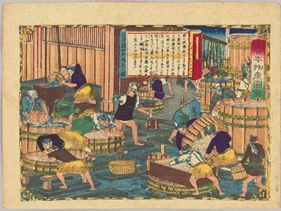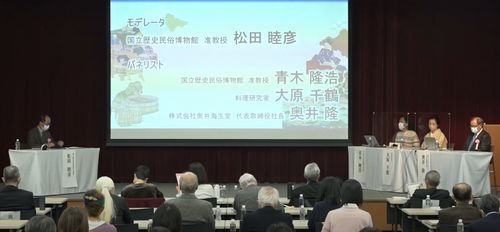Joint Symposium by the National Institutes for the Humanities and the Ajinomoto Foundation for Dietary Culture: “Exploring What the Dainihon bussan zue [Products of Japan] Nishiki-e Series Reveals about Japan’s Food Culture and Production between the Edo

The National Institutes for the Humanities (NIHU) has been organizing and hosting symposiums since 2018 in collaboration with the Ajinomoto Foundation for Dietary Culture to present the results of studies on culinary culture. The sixth symposium was held in person on November 11, 2022 on the theme of “Exploring What the Dainihon bussan zue [Products of Japan] Nishiki-e Series Reveals about Japan’s Food Culture and Production between the Edo Period (1603–1867) and Today.” Video recordings of the event have been available since February 10, 2023 on the YouTube channels maintained by NIHU and the Ajinomoto Foundation for Dietary Culture.
[Lecture 1]
OKUBO Jun'ichi (Professor, National Museum of Japanese History)
The first presentation, by Dr. OKUBO Jun'ichi on “Examining the Culinary Culture of the Edo Period (1603–1867) and the Meiji Era (1868–1912) through UTAGAWA Hiroshige III’s (1842–1894) Dainihon bussan zue [Products of Japan] Series,” provided an overview of the collection of 118 colorful (nishiki-e ) woodblock prints archived at the Ajinomoto Foundation for Dietary Culture. Publication of zue—compilations of illustrations and drawings—increased in the late Edo period. From that genre a subcategory called bussan zue emerged, depicting specialty goods from around the country. The bussan zue format was then adopted into nishiki-e , the colorful woodblock prints rendered in ukiyo-e style. The Dainihon bussan zue [Products of Japan] series by Hiroshige III (ANDŌ Tokubei), compiled and issued in 1877 by OKURA Magobei (1843−1921)—who ran a publishing business in Nihonbashi—was put on display and sold at the art pavilion of the first National Industrial Exposition (Naikoku Kangyō Hakurankai) that the government hosted the same year to promote domestic industrial development.
● The Dainihon bussan zue [Products of Japan] series
Since appearing in the late Edo period, nishiki-e remained popular until the early twentieth century as prints specifically published in the city of Edo, today’s Tokyo. The Dainihon bussan zue [Products of Japan] nishiki-e series consists of 118 extant prints by UTAGAWA Hiroshige III, each depicting scenes of people around Japan working to produce their local specialties, and published by OKURA Magobei of Nihonbashi. The collection was published in 1877 to coincide with the first National Industrial Exposition (Naikoku kangyō hakurankai).

Settsu no kuni Itami shuzō no zu [A Sake Brewery in Itami, Settsu Province] from the Dainihon bussan zue series
[Lecture 2]
AOKI Takahiro (Associate Professor, National Museum of Japanese History)
In the second presentation, Dr. AOKI Takahiro spoke on the theme “Exploring Modern Sake-Making by Referencing the Dainihon bussan zue [Products of Japan] Series,” examined the Dainihon bussan series and other examples of sake-themed zue, and, sharing observations from his own visits to breweries, explained how sake likely tasted in the early Meiji (1868–1912) around the time the collection was published. Comparing the artwork of Hiroshige III with that of Itami shuzō kome arai no zu [Rice-Washing at a Sake Brewery in Itami] from the 1799 Nihon sankai meisan zue [Famous Products of Land and Sea in Japan] series, Dr. AOKI discussed what he found odd as to details of the images and commentaries in the prints in Settsu no kuni Itami shuzō no zu [A Sake Brewery in Itami, Settsu Province] and Settsu no kuni shinshu nidashi no zu [Shipping Fresh Sake in Itami, Settsu Province], both of which are part of the Dainihon bussan zue collection.
[Lecture 3]
OKUI Takashi (President, Okui Kaiseido)
The third presentation, themed “Japanese Food Culture and Konbu Kelp: Its History and Future,” was given by Mr. OKUI Takashi. Mr. OKUI is the president of a company specializing in producing and processing konbu, a type of seaweed widely used in Japanese cuisine. His lecture covered the history of konbu, its characteristics as an ingredient, and its international and other distribution channels. People in Japan started to commonly consume konbu around the mid-eighteenth century when the kitamae bune [lit., north-bound ships] merchant ship route, carrying kelp and other produce and goods, connected Hokkaido and Osaka along the Sea of Japan and the Inland Sea. According to Mr. OKUI, there are four categories of Hokkaido konbu based on the areas where it is harvested and the product is similar to wine in that the pricing reflects the rating. The president also said konbu has recently been enjoying greater attention with the increasing popularity of Japanese cuisine worldwide, noting how he has been engaged in international konbu-related interchange—taking interviews from overseas media and giving lectures abroad, to name a few examples.
[Round-table discussion]
Moderator: MATSUDA Mutsuhiko (Associate Professor, National Museum of Japanese History)
Panelists: AOKI Takahiro, OOHARA Chizuru (culinary expert), and OKUI Takashi
The round-table discussion featuring Dr. AOKI, Mr. OKUI, and culinary expert Ms. OOHARA Chizuru, and Mr. OKUI explored why Settsu no kuni Itami shuzō no zu [A Sake Brewery in Itami, Settsu Province] only depicts the rice-washing and water-soaking processes, as well as the parallel between contemporary makonbu (Japanese kelp) harvesting methods and the scene in Dōkoku (Mutsu) Tsugaru konbutori no zu [Konbu Harvesting in Tsugaru, Mutsu Province]. Then Ms. OOHARA shared how chefs choose different types of kelp to best match the meal or the mineral content of the water used in the cooking process. Aside from the Dainihon bussan zue, the discussion extended to the current food culture surrounding konbu and sake, as well as the interrelation between produce (e.g., sake and konbu), humanity, and the environment including water and the sea. The event was a great success overall.

Scene of round-table discussion
(Text: OHBA Go, Researcher, Center for Innovative Research, National Institutes for the Humanities)
